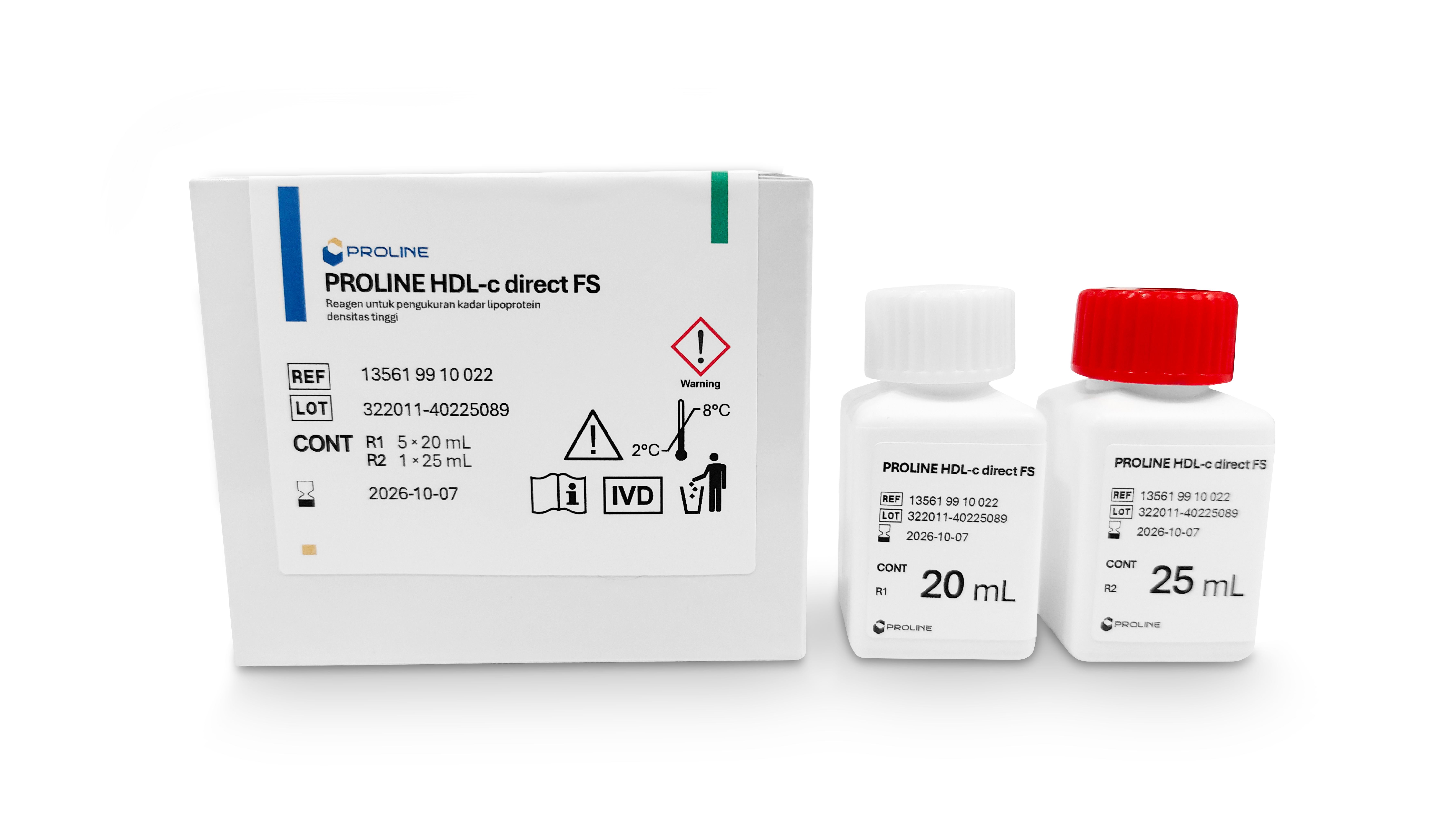PROLINE HDL-c direct FS

| Catalog Number | R1 Reagent Volume | R2 Reagent Volume |
| 13561 99 10 022 | 5 x 20 mL | 1 x 25 mL |
| 13561 99 10 025 | 3 x 80 mL | 1 x 60 mL |
| 13561 99 10 029 | 3 x 200 mL | 1 x 150 mL |
| 13561 99 10 920 | 4 x 38 mL | 4 x 11 mL |
| 13561 99 10 921 | 4 x 23 mL | 4 x 7 mL |
| 13561 99 10 191 | 4 x 36 mL | 4 x 9 mL |
| 13561 99 10 181 | 4 x 36 mL | 4 x 9 mL |
Diagnostic reagent for the quantitative measurement of high-density lipoprotein cholesterol (HDL-c) in human serum or human heparin plasma in vitro using a photometric system.
HDL-c direct FS is a homogenous block-polymer based assay for direct determination of high-density lipoprotein cholesterol (HDL-c) in serum and plasma. This lipoprotein class is characterized by a protective effect impeding atherosclerotic plaque formation. Thus, reduced HDL-c concentrations are associated with high risk of atherosclerotic heart disease.
Cholesterol is an essential component in the body, synthesized by cells and absorbed from food. It serves as a part of cell membranes and as a precursor for steroid hormones and bile acids. In plasma, cholesterol is transported by lipoproteins, which are complexes of lipids and apolipoproteins. There are four main types: HDL (high-density lipoprotein), LDL (low-density lipoprotein), VLDL (very low-density lipoprotein), and chylomicrons.
HDL-c (high-density lipoprotein cholesterol) plays a vital role in protecting the body by inhibiting the formation of atherosclerotic plaques in the arteries. HDL-c is also involved in the process of removing cholesterol from peripheral cells and body tissues, which is then transported to the liver for further processing. Additionally, HDL-c has antioxidant effects and acts as a mediator of inflammation and antithrombotic responses.
Using a homogeneous method for measuring HDL cholesterol without the need for centrifugation steps (direct method).
- Ready-to-use liquid reagent (open-system) without reconstitution
- Excellent linearity and stability performance
- Available in MPK (Multi-Purpose Kit) and dedicated kit
- Compatible with >65 brands of manual and automated clinical chemistry analyzers
| Sample type | Human serum or lithium heparin plasma |
| Measurement range | 3 mg/dL - 200 mg/dL |
| Analysis wavelength | 578 nm (550 – 650 nm) |
| Analysis mode | End-Point |
| Reagent volume used (analyzer manual) | R1: 1000 µL ; R2: 250 µL |
| Sample volume used (analyzer manual) | 10 µL |
| Storage temperature | 2 – 8 °C |
| Open vial stability | 24 months |
| Expiration date | 24 months |
| Control for HDL Reagent | Calibrator for HDL Reagent |
| TruLab L Level 1 | TruCal Lipid |
| TruLab L Level 2 |
| Reference Range: | ||
| mg/dL | μmol/L | |
| Low HDL cholesterol (major risk factor for CHD) | < 40 | < 1.04 |
| High HDL cholesterol ('negative' risk factor for CHD) | ≥ 60 | ≥ 1.55 |
- HDL-c direct reagent
- Doos
- Kit insert
- Reagents bottle
- Kit Insert PROLINE HDL-c Direct FS (13561 01 – Apr 2025/04)
- Gordon DJ, Probstfield JL, Garrison RJ, et al. High density lipoprotein cholesterol and
cardiovascular disease. Four prospective Amaerican Studes. Circulation. 1989;79: 8-15. - Favari E, Chroni A, Tietge UJF et al. High Density Lipoproteins: From Biological Understanding to Clinical Exploitation. Springer Verlag; Volume 224, 2015; p. 181-206.
- Brochure : INA
- Aterosklerosis
- Metabolisme Lipid
Contact our team to find out more product information and ordering
- Telp : +62 21 8984 2722
- WhatsApp : +62 815 1359 2626
- Email : marketing@proline.co.id
Contact our Technical support team for further assistance with product specifications, services and other technical documents.
- Telp : +62-21-8984-2722
- WhatsApp : +62-817-9324-884
- Email : technical.support@prodis.co.id
